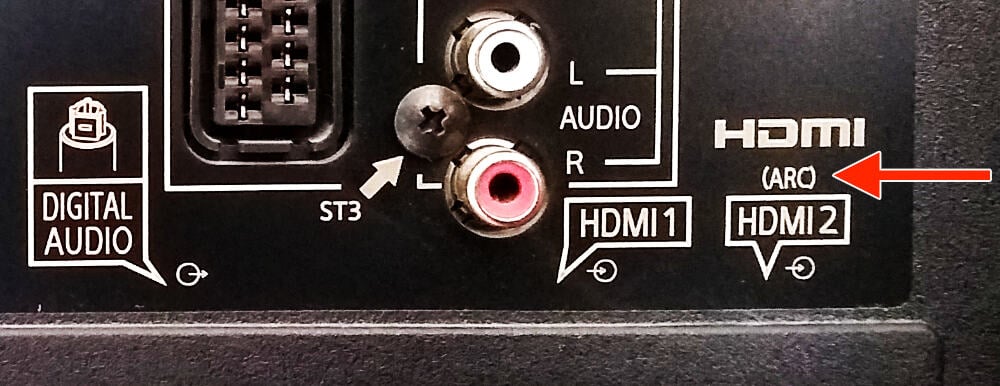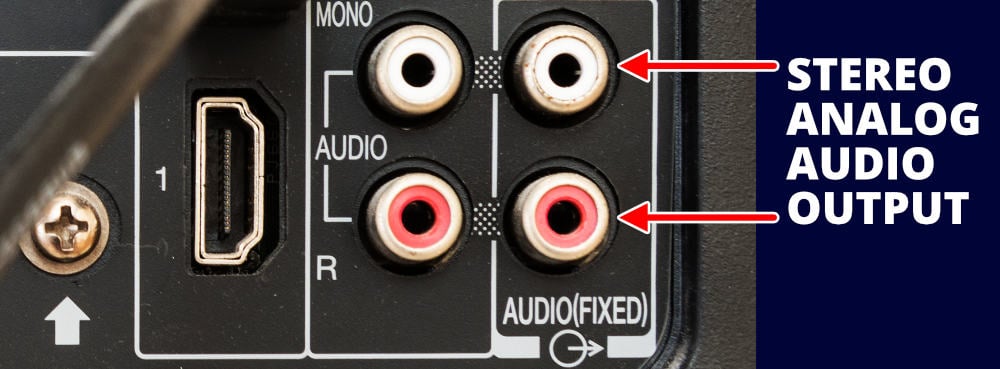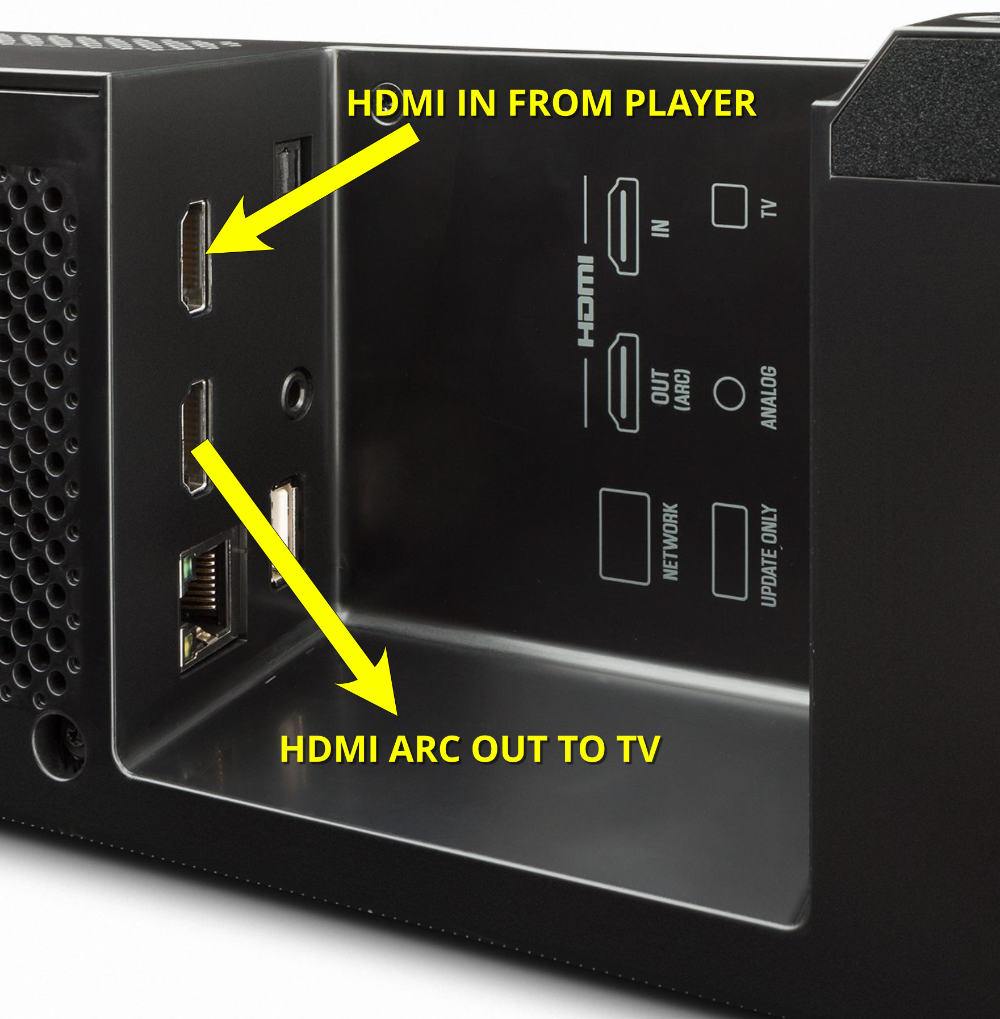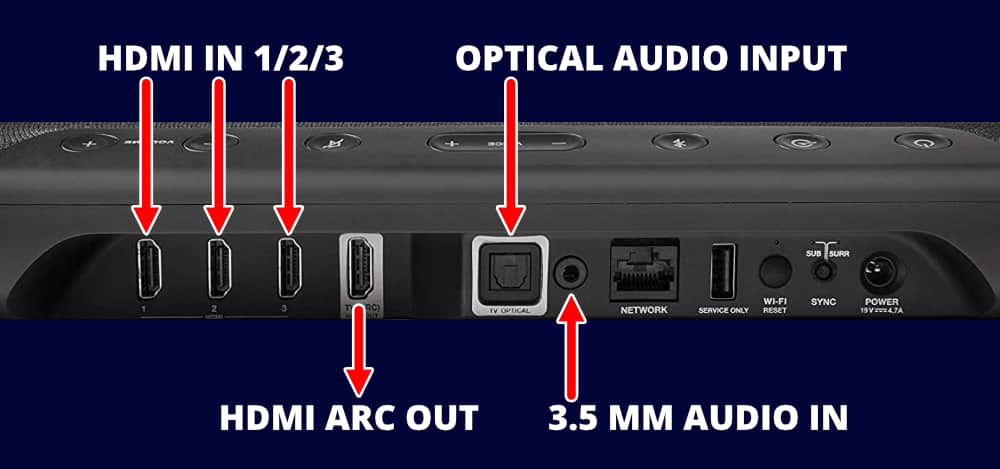Connecting a soundbar to a TV is the easiest way to improve the sound of TV shows and movies for many. However, even though it’s pretty simple, hooking up a soundbar can still offer a few head-scratching moments.
This article covers the four primary ways of connecting a soundbar:
- Using HDMI
- Using an optical cable
- Using a coaxial cable
- Using stereo analog audio
You will also learn how to connect external devices to your soundbar, a common issue when you want to listen to audio from sources other than your TV’s built-in apps.
Key Points
- Use an HDMI ARC/eARC connection between the TV and soundbar for the best audio quality. Make sure to enable HDMI-CEC in the TV’s settings.
- Alternatively, use an optical or coaxial digital audio cable if HDMI ARC is unavailable.
- For older equipment, connect using analog RCA stereo cables or a 3.5mm headphone jack cable.
- If your soundbar has only one input, connect extra external devices to the TV inputs. The TV will then pass audio to the soundbar, although this can disrupt surround sound.
Main Topics
Connecting With an HDMI Cable
This is the most up-to-date method of connecting AV devices. Therefore, it is one of the best ways to connect your television and soundbar.
But you can only do this if your soundbar and TV support it.
Your TV will need one HDMI ARC (Audio Return Channel) or eARC (Enhanced Audio Return Channel) port to connect a soundbar via HDMI.
Most modern TVs have several HDMI inputs, but one must support ARC or eARC for connecting a soundbar.
To identify the correct connection, look for the ‘ARC’ or ‘eARC’ label next to one of the HDMI ports on your TV’s back or side.

The brand of the TV doesn’t matter. Most modern TVs from popular brands now offer support for the HDMI Audio Return Channel.
The advantage of an ARC port is that the TV will be able to send audio from the TV and into the soundbar – including Dolby Digital and Dolby Atmos audio.
HDMI ports that don’t support ARC are ‘input’ only – meaning they can’t send audio from the TV, only receive sound from an external device.
If the port is labeled ‘eARC,’ this is fine too. This newer version of ARC will also work with any ARC connection.
The primary benefit of eARC is that it supports a higher data bandwidth and plays high-resolution audio formats like Dolby TrueHD and DTS-HD-Master Audio.
However, you won’t get these on most TV channels and streaming services. Of course, you also need to check if your soundbar supports an ARC connection.
But if your soundbar has an HDMI port, it probably does.

Image Credit: Sonos
Above, you can see the rear input connections of the popular Sonos Beam soundbar.
These newer Sonos soundbars, like the Beam and Arc, support connecting with HDMI ARC to your TV.
Step 1: Connect the HDMI Cable
Connect an HDMI cable from the TV’s HDMI Audio Return Channel port – and connect the other end to the soundbar’s HDMI input.

Any standard (category 1) or high-speed (category 2) HDMI cables will send audio over HDMI ARC.
Step 2: Select the Correct TV Audio Output
Using the TV screen, go to the TV sound setup audio menu and change the TV sound output setting from ‘TV Speaker’ to ‘External Speakers’ (or words to that effect).
The menu might say ‘Home Theater’ or list the available audio types. If the sound output types are listed, select the connection method you will use.
So, in this case, select HDMI or HDMI ARC.

With some TVs, you can turn the TV speakers on or off in this menu, and it’s best to turn them off if you use external speakers.

The aim is to disable the TVs’ built-in speakers because you don’t want the sound from the TV and soundbar simultaneously.
If your TV doesn’t have the option to turn off the speakers, just turn the volume down to zero.
Step 3: Enable HDMI-CEC
You might not need step 3, and your soundbar will now work. However, try this option if you still don’t get any sound.
Go to the TV setup menu and make sure HDMI-CEC is enabled. HDMI-CEC is called different things depending on the brand of the TV.
Some examples are:
- Samsung: Anynet+
- Sony: BRAVIA Link
- Pioneer: Kuro Link
- LG: SimpLink
- Panasonic: VIERA Link
- Philips: EasyLink
In the example here, the SimpLink HDMI CEC is enabled in the menu of an LG OLED TV:

The CEC setting allows the soundbar and TV to control each other over an HDMI connection with a single remote control – like changing the volume or turning everything on or off.
Most people using a soundbar will want CEC-enabled, but in some setups, you may wish to disable this if you use a separate control system or universal TV remote.
You may need to enable this setting because HDMI ARC and HDMI-CEC are often both required for the soundbar to work correctly.
Learn more about HDMI control here.
Step 4: Test the Soundbar
Turn on your TV and select a channel with some interesting audio. A music or movie channel can be good for putting your soundbar through its paces.
It’s also helpful to try an app like Netflix to ensure the app is also sending audio to your soundbar.
If you don’t get any sound, re-check the wiring and ensure you have the correct settings in the TV’s audio output menu.
Also, ensure the volume is up using your remote control.
Using an Optical Cable
Before HDMI ARC, digital optical audio was the most common way to connect a television and a soundbar.
Although less common now, optical audio is still widespread and a good way of sending audio from your TV to a soundbar.
You can use optical to connect your soundbar if your TV has an optical output – and your soundbar has an optical audio input.
Optical outputs are still quite common on a wide range of televisions, and you should be able to find one on the back of your TV.

If in doubt, grab the TV manual, which will tell you where the optical output is – or if there is one. Many soundbars also come with optical audio inputs.

Image Credit: Yamaha
So, if you can’t use HDMI for connecting your soundbar, the next best solution is to use an optical connection.
The choice between HDMI or optical usually depends on your device’s connections. Use HDMI if you can – or optical if not.
Step 1: Connect the Optical Cable
Hook up an optical digital audio interconnect cable from the TV optical audio out connection to the soundbar’s optical input.

You don’t need to spend a fortune on a cable.
The AmazonBasics range is sufficient, or there are plenty of good, well-made cables like the KabelDirekt Optical Digital Audio Cable that don’t cost the earth.
Just make sure you buy the correct length of cable for the job!
Step 2: Enable the Correct TV Speaker Setting
Go to the TV audio setup menu and ensure the TV sound output is set to external speakers/optical out.
If that’s unavailable, you may just have the option to turn the TV speakers off. If so, select this option to disable the onboard speakers.
In some TVs, the optical output is permanently enabled; you just need to wire it up, and it will work.
If there is no audio menu option at all, simply turn the TV volume down to zero using the remote control.
Why? Because you don’t want the sound coming from the TV and soundbar simultaneously, which will make the sound less clear.
Step 3: Test You Have Sound
The final stage is the most important: ensuring you have connected everything correctly.
Switch on the television and select a channel with plenty of exciting audio – movies or music are a good choice. Hopefully, you will hear the improved sound through your soundbar.
If not, check your cable is pushed in sufficiently, double-check the audio menu output settings, and ensure you have the volume turned up.
Using a Coaxial Cable
Although optical digital audio ports are more common, you may have a TV or soundbar with a coaxial connection for sending and receiving audio.
These work in much the same way as with optical. The main difference is that you must buy a digital coaxial cable to connect your devices.
Step 1: Connect the Coaxial Audio Cable
Connect a coaxial digital audio interconnect cable from the TV’s audio out connection to the soundbar’s coaxial input.

You must buy a 75-ohm coaxial digital audio cable to ensure the digital signal will transmit correctly with no errors.
This Mediabridge Ultra Series Digital Audio Coaxial Cable is a popular choice on Amazon.
Step 2: Enable the Correct TV Speaker Output
Go to your TV’s audio setup menu and disable the onboard speakers.
There should be a menu item to select the speaker output as coaxial audio – or it may just say ‘external speaker.’ Something like that.
If your TV doesn’t appear to have this setting, turn the TV volume to zero using your remote.
On some TVs, the coaxial output will always be enabled, so you should hear audio regardless.
Step 3: Test the Sound
When you switch on the TV, you should hear audio from the soundbar.
If so, you are all set – although you might want to check some of the built-in apps and make sure you get sound from them too.
If you don’t hear anything, check you have turned up the volume to a reasonable level.
If you still hear no sound from the channel you are viewing, replug the coaxial cable in the TV and soundbar, and go back to the TV’s audio setup menu to see if you have selected the correct audio output.
Using Coaxial to Optical Converters
A potential issue with digital audio connections is that a coaxial connection is less common on newer TVs and soundbars.
So, even if you have a coaxial connection on one device, it is less likely that you will have a coaxial connection on both devices.
If your TV has a coaxial output – and your soundbar has an optical input – then you can use a coaxial to optical converter to change the audio type.
- Use it if you don't have the correct digital audio connections on your device
- Bi-directional so you can convert both ways
- Supports uncompressed stereo PCM audio and 5.1 Dolby Digital and DTS
- Works up to 30 meters
- Power connection required
You would connect a coaxial to optical converter like this:

Then, you need to make sure that you go to the TV setup menu to select the correct sound output.
You can also use a converter if you need to change the audio in the other direction – from optical to coaxial.
Some converters will work both ways – like the one suggested above – while others will only convert from one type to another. Therefore, double-check you pick the correct converter before you buy.
Connecting a Stereo RCA Cable
If your TV or soundbar doesn’t support HDMI, optical or coaxial, you will probably need a stereo analog RCA connection.
Often, budget or older models will have this type of analog connection.
You may also find a stereo analog audio connection on soundbars with multiple inputs to connect more external devices to your soundbar.
The easiest way to connect this up is to use a standard stereo analog audio wire from the red and white RCA line out on the TV.
The stereo analog output on the back of your TV will look something like this:

And the cable you need is just a simple stereo RCA cable like this:

You probably have dozens of these lying around the house already.
Just connect the red and white connectors to the same color RCA connections on your devices:

Unfortunately, AV devices have all sorts of different connection types.
If your TV doesn’t have a stereo analog line-out connection, you may be able to use the TV’s headphone jack instead.
You will need a 3.5mm mini jack to stereo RCA cable for this. It’s not ideal, as the headphone output will send a weaker audio signal than the stereo line-out. So, the audio quality won’t be as good.
But, if you turn up the TV’s volume, you should get something that will work.
Connecting a Stereo RCA Soundbar to an Optical Output
Newer TVs don’t often have a stereo analog output.
So, if your TV only has an optical output – and you have a soundbar with stereo analog inputs – then you can buy an optical-to-stereo analog converter:
- Optical and coaxial digital audio inputs
- Accepts PCM and Dolby/DTS 5.1 input audio
- 192/24 lossless decoding
- Output volume control
- Only outputs stereo analog audio, not surround sound.
You would then connect it like this:

Converter boxes like this make switching from one audio type to another easy.
In most cases, you need to make sure that you set the audio menu on your TV to output PCM.
This means that the TV will send stereo PCM audio from the optical output – rather than 5.1 surround sound – and many digital converters only accept PCM audio.
However, the converter pictured above will decode surround sound DTS and Dolby Digital, so you are not limited to stereo PCM like many devices.
Of course, the resulting audio output will still be stereo-only.
To learn more, check out how to use an optical to RCA converter.
How to Connect Several Devices to Your Soundbar
Another consideration when connecting your soundbar is how many devices you want to connect to it.
If you only want to hear your TV’s sound on the soundbar, it’s simple – you just need to make one of the connections mentioned above.
However, what if you have a Blu-ray or DVD player? Or a game console? Or, how do you hook up your cable box to your soundbar?
The answer, again, depends on which soundbar you have. Some soundbars have multiple inputs – maybe 2 or 3 HDMI or optical inputs.
In this case, you can just run a cable from each device into the soundbar.
However, many soundbars just have a single connection. So how do you hear all your other devices on the soundbar?
Here’s how you would do it.
Soundbars with Single Inputs
Many soundbars have a single audio input for receiving audio from your TV.
So, does that mean you can’t hear the audio from your game console, cable box or DVD player on your soundbar? Not necessarily.
If you want that, the best way is to connect all your external devices directly to the TV, then use the television’s audio output to pass all the incoming audio to the soundbar.
You would wire it something like this:

Most modern TVs have several HDMI inputs for multiple external devices.
So once you have connected everything, you just need to make the usual audio connection to your soundbar.
That will usually be an HDMI ARC connection, so don’t use that HDMI port to connect an external device.
Alternatively, you might need to use the optical output to connect your soundbar. It depends on the connections that your TV and soundbar have.
Problem: Downmixing Multichannel Audio to Stereo
A potential problem with this scenario is that some TVs won’t pass multichannel sound and will downmix the incoming audio to stereo before sending it out.
This won’t be a problem if you only require stereo sound with your soundbar.
However, if you are playing a DVD with 5.1 surround sound, and your soundbar is part of a system with surround sound speakers, you will be disappointed when you only get stereo audio on your soundbar.
Unfortunately, there isn’t an easy solution to this. You could connect the DVD player directly to the soundbar if you can.
Or, you can buy a TV that will pass surround sound audio from its digital audio output.
Soundbars with Multiple Inputs
Other soundbars have several extra inputs for your external devices. A good example is the Yamaha MusicCast BAR 400 soundbar.

Image Credit: Yamaha
You can see from the picture above that this soundbar has two HDMI connection ports.
One is an input to receive the signal from an external device, like a Blu-ray player, set-top box or game console – allowing the soundbar to play the Blu-ray movie or game audio.
The other is an HDMI output that will pass the video signal to the TV.
Because this is an ARC connection, you can also pass audio from the TV to the soundbar using the same HDMI port.
If you’re still confused, maybe this simplified wiring diagram will make it clearer:

The idea is to connect all your external devices to the soundbar inputs – but you still have the second HDMI connection to receive sound from the TV.
This is similar to how you would connect an AV receiver, and although it allows you to connect more devices, it does add the problem of more wires to hide when you install everything.
The article on soundbar placement ideas gives you options on the best way to mount your soundbar and hide the cables.
In the example of the Yamaha MusicCast BAR 400 soundbar, there is also an optical connection to pass TV audio for TVs that don’t support HDMI ARC.
Some soundbars have more inputs than this – and different types – but the way you connect everything will follow the same principle as above.
Here’s another example. The popular Polk Audio MagniFi Max SR soundbar has a standard ARC connection for your TV.
Alternatively, you can connect the TV’s output to the optical input.

Image Credit: Polk Audio
However, if you use the HDMI ARC connection, there are 3 further HDMI inputs you can use to connect all your other devices with HDMI ports.
Then, the HDMI ARC connection will pass the picture to the TV – leaving the soundbar to play all the audio.
If you aren’t using the optical input for TV sound, you can also use the optical connection for an audio-only device – such as a CD player.
Using a soundbar with multiple inputs can be an excellent way to get a home theater sound system in your room.
It allows you to connect multiple devices and improve the sound in your room simultaneously.
You just need to make sure that you think about the number and type of connections required for your room.
Check out the best TV soundbars for a range of soundbars at different price points, which you may find helpful if you haven’t made your choice yet.
Frequently Asked Questions
Can You Connect Speakers Directly to Your TV?
Most speakers cannot be connected directly to a TV. Typical home theater speakers are passive, meaning they must be wired to an amplifier. However, active speakers have internal amplification, so they can connect straight to your television. The majority of soundbars are active speakers.
How Do You Get Your TV to Recognize Your Soundbar?
If you can’t get your TV to recognize your soundbar, you probably need to change a setting in the TV’s audio setup menu. Once you have wired the soundbar to the TV, ensure the TV’s audio output is assigned correctly. For example, if you use HDMI, change the TV’s audio output from ‘TV Speaker’ to ‘HDMI ARC.’
Can You Connect Any Soundbar to Any TV?
You can connect most soundbars to almost any TV. The critical consideration is the connection types available on each device. HDMI ARC is the standard connection method, but the TV and soundbar must both support this. If not, check if the TV and soundbar allow for optical or coaxial digital audio connections.
Why Is Your Soundbar Not Working With Your TV?
If your soundbar isn’t working with your TV, check the cable is wired correctly to both devices. Next, go to the TV’s setup menu and ensure the audio output is set to the connection you are using – usually HDMI, optical or coaxial. You may also need to enable HDMI-CEC in the TV’s menu if using HDMI ARC.
About The Author
Paul started the Home Cinema Guide to help less-experienced users get the most out of today's audio-visual technology. He has been a sound, lighting and audio-visual engineer for around 20 years. At home, he has spent more time than is probably healthy installing, configuring, testing, de-rigging, fixing, tweaking, re-installing again (and sometimes using) various pieces of hi-fi and home cinema equipment. You can find out more here.






